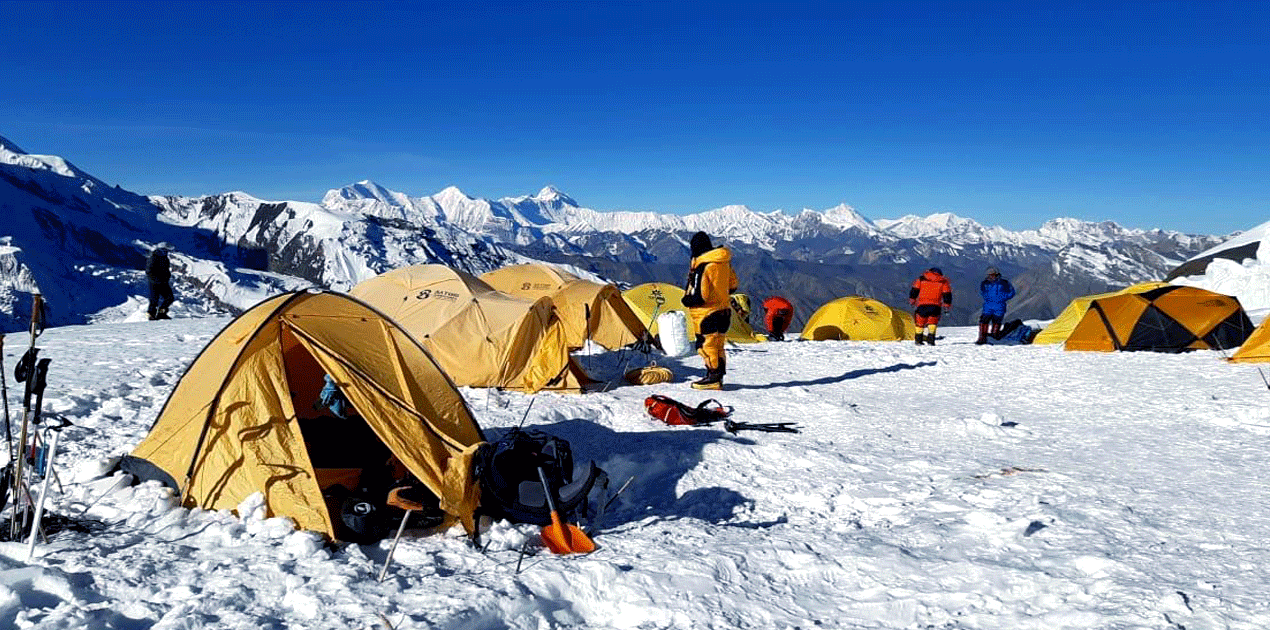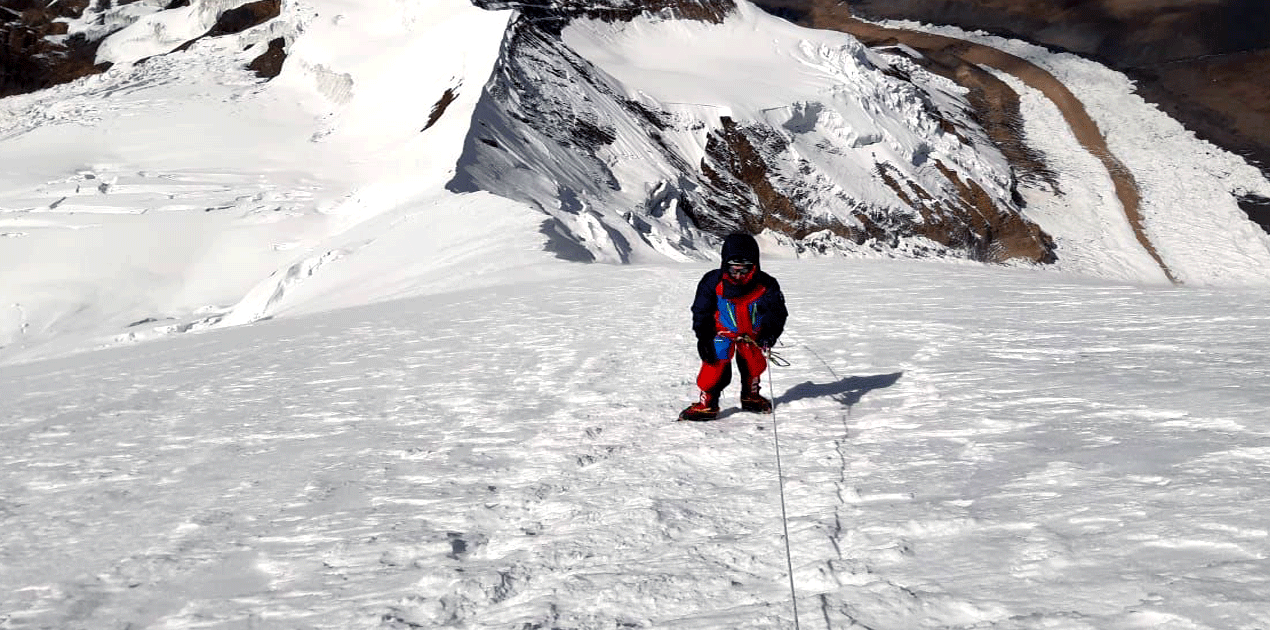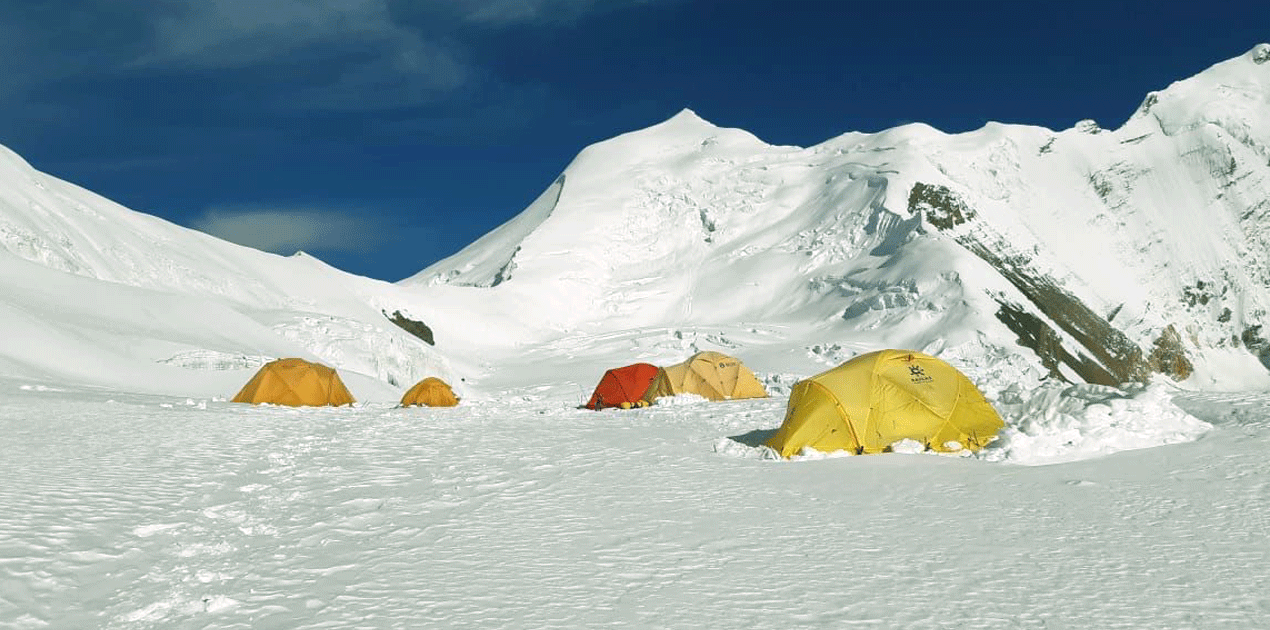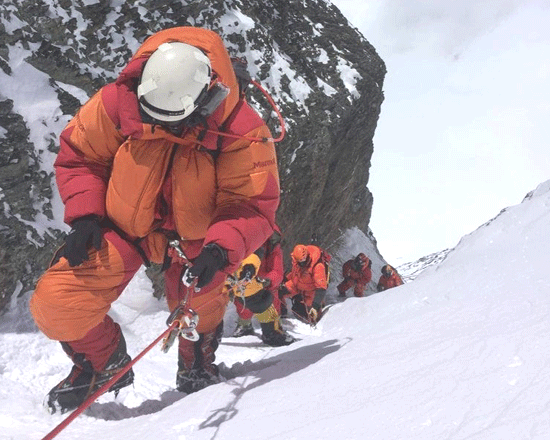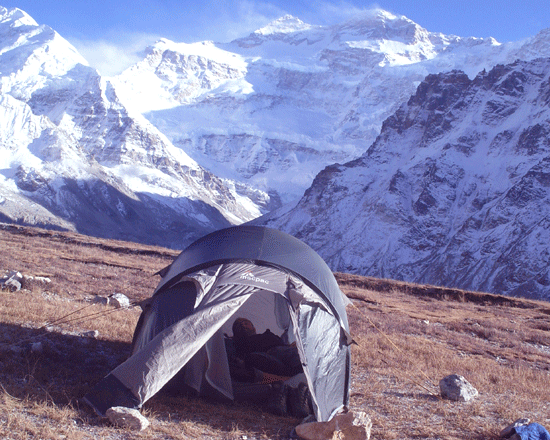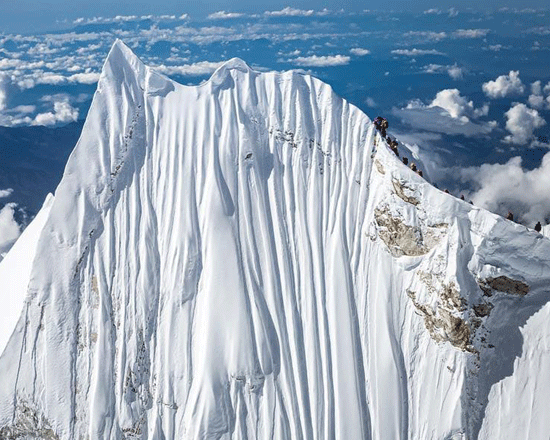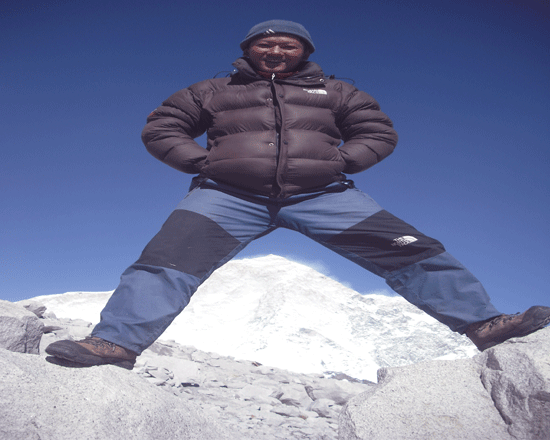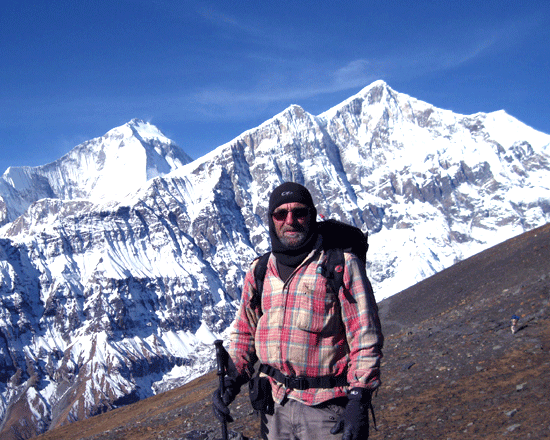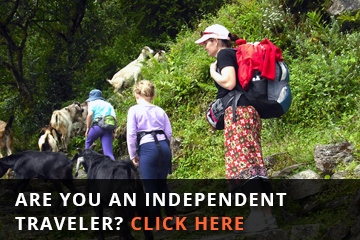Himlung Expedition
Himlung Expedition
High mountain expeditionsTrip Facts
These treks are suitable for any walker looking for something a little more challenging and energetic. They are a combination of some longer and shorter walks and hill-walking experience is desirable. The duration is usually from 10 to 15 days. Following the up and down terrain of Nepal and walking to higher elevations contrasts these treks to those in the easy classification. However, you will be rewarded for your efforts with spectacular close-up views of glaciers and of the high Himalayas. Although the terrain is not difficult, some vigorous hiking experience is useful. There may be up to 6 hours a day on the trail and the elevation rises and falls from 800m/ 2624ft to 4000m/13210ft above sea level.
100%
Overview
Himlung Himal Expedition
The Himlung Expedition is one of the most alluring mountain summits, offering exhilarating enjoyment for mountain climbers. Himlung Himal situated in Nepal’s Manaslu region, has emerged as a coveted destination for mountaineers yearning to conquer a Himalayan pinnacle. Towering at an impressive altitude of 7,126 meters (23,380 feet), this majestic mountain demands exceptional technical climbing skills and experience to reach its summit.
The Himlung Expedition presents an excellent choice for climbers, characterized by a gradual ascent that necessitates minimal technical expertise. Reaching the summit unveils breathtaking panoramas of the surrounding landscape. With a reasonable timeframe, this climb poses no significant challenges, making it an ideal high-altitude mountain expedition for those with some mountaineering experience and a burning desire to explore Nepal.
The Himlung Expedition commences west of Kathmandu in Beshishar at an elevation of 840 meters. Following the esteemed Annapurna Circuit Trekking route up the Marshyangdi River valley, we venture into the enchanting Phu Valley of the secluded Gandaki region. Within this valley lie the ancient Tibetan settlements of Naar and Phu, nestled just a stone’s throw away from the towering Himlung Himal. Dedicate a day to acclimatization and immerse yourself in the picturesque Buddhist settlement, embracing the serenity it offers. Our Himlung Base Camp, positioned at a lofty altitude of 4,900 meters, rests on a verdant meadow overlooking the village of Phu.
Before setting our sights on conquering Mount Himlung’s summit, we establish three additional camps: Camp I at 5,450 meters, Camp II at 6,000 meters, and Camp III at 6,350 meters. While our primary objective remains to reach the Himluing summit, our diligent Sherpas prioritize your comfort and safety. Thus, the itinerary remains flexible, allowing adjustments based on climbers’ health conditions and prevailing weather on the mountain. Leading you through the crucial process of acclimatization, our team of professional and experienced Local Sherpa Guides expertly navigate paced ascents and descents, preparing your body for the challenges of high altitude.
Himlung Base Camp to Camp I
Himlung Base Camp is cozy and located in a sheltered area with ample water sources nearby, ensuring comfort while shielding against avalanches. However, the journey to set up camp presents a slight challenge, as it entails maneuvering through the Pangir Glacier amidst colossal boulders, followed by an exposed ascent up the moraine on the right bank, susceptible to rockfalls.
From Camp I to Camp II
The transition from Camp I to Camp II is a relatively straightforward and swift endeavor, taking approximately 2 to 3 hours along moderately undulating terrain, punctuated by moraines and small valleys. Snow conditions may influence progress, but there are no avalanche-prone slopes along the ascent. To reach Camp II, you must navigate a perched scree slope, leading directly to the side of the glacier. Traversing the glacier side, with its crevasses and challenging terrain of rocks and snow, eventually leads to flatter glacier terrain, requiring careful steps and a few twists and turns. This section presents the most thrilling segment of the ascent. Continuing our glacier journey, we skillfully maneuver around crevasses until we reach the “Glacier Camp,” a well-suited site for establishing our camp.
The Second and Third Camps
The path from Camp II to Camp III presents minimal challenges, with an ascent up icy escarpments leading to the final ridge. This leg should take approximately 2-3 hours from Camp II. Consequently, the risk of avalanches from above slopes is minimal or nonexistent.
Summit – Camp II or I
During the Himlung Expedition, additional high camps could not be added to shorten the climb. The initial stage involves reaching the pass via slightly steep (30°) and exposed snowy slopes. In certain cases, lead guides may install fixed ropes. Beyond this point, the slopes become gentler, interspersed with flat sections.
Once the crevasse opens, typically posing no hindrance, the ridge-side slope steepens, representing the most challenging part of the entire ascent. Spanning 400 meters at 30/35 degrees, this section carries a higher risk of falling. Consequently, fixed ropes are employed. The route then leads to a less steep ridge, transitioning to a flatter section before the final short slope. Descending to either Camp II or Camp I, we prepare for the return journey to base camp the following day. Packing our gear, we celebrate our summit triumph, relish the gratification of our accomplishments, and prepare for the concluding leg toward Kathmandu.
The itinerary for the Himlung Expedition spans 28 days from the day of arrival. Nepal Wilderness Trekking assumes responsibility for all aspects of the Himlung Expedition, including permits, fees, and trail accommodations. Our unwavering priority remains your safety and satisfaction. As a seasoned trekking and climbing company with over 20 years of experience, we distinguish between a good and exceptional experience. We take immense pride in our reputable standing.
Best Time for Himlung Expedition
The best time for Himlung Expedition is during the spring (April-May) and fall (October-November) seasons. During these seasons, the weather is stable, and the skies are clear, making it easier to navigate the mountain. The temperatures are also milder during these seasons, which makes it more comfortable for climbers to trek and climb.
The spring season is considered the best time for Himlung Expedition because it is the beginning of the climbing season in Nepal, and the mountain is less crowded. The weather is stable, and the skies are usually clear. During this season, the temperatures are mild, and the mountain is covered with snow, making it easier to navigate.
The fall season is also a great time for Himlung Expedition because the monsoon season has ended, and the skies are clear. The temperatures are mild, and the mountain is usually dry, making it easier to climb. The fall season is also a popular time to climb in Nepal, so there may be more climbers on the mountain during this time.
It is important to note that the summer monsoon season (June-September) and winter (December-February) are not suitable for the Himlung Expedition due to heavy snow and unstable conditions. The monsoon season brings heavy rain and snow to the region, which can make the trek to the mountain difficult. Winter brings extreme cold and snow, making it challenging to climb the mountain.
Essential Information for Himlung Expedition
Permits: You will need to obtain a climbing permit from the Nepal government to climb Himlung. The permit fee varies depending on the season and the size of the climbing team.
Logistics: Himlung Himal is located in a remote region of Nepal, and reaching the mountain involves a long trek to the base camp. You will need to arrange for transportation, guides, porters, and other logistics to reach the mountain.
Climbing Season: The best time for Himlung Expedition is during the spring (April-May) and fall (October-November) seasons, when the weather is stable and the skies are clear. The summer monsoon season (June-September) and winter (December-February) are not suitable for climbing due to heavy snow and unstable conditions.
Climbing Route: There are several routes to climb Himlung, but the most popular route is the North Ridge. The climb involves steep snow and ice slopes, and some technical rock climbing sections.
Physical Fitness: Climbing Himlung requires excellent physical fitness and stamina, as well as strong mountaineering skills. You should be prepared to spend several weeks at high altitudes and endure harsh weather and environmental conditions.
Safety: Climbing any Himalayan peak involves risks, and safety should always be a top priority. You should climb with an experienced guide and team and have the proper equipment and training to handle any emergencies that may arise.
A Himlung expedition can be a challenging and rewarding experience for experienced mountaineers seeking to climb a lesser-known Himalayan peak. However, it is important to be well-prepared and to approach the climb with caution and respect for the mountain and the environment.
Detail Itinerary
- Day 01: Land in Kathmandu
- Day 02: Kathmandu preparation day
- Day 03: From Kathmandu to Besisahar, 7 hours and 800 meters (2,624 feet)
- Day 04: Drive from Besi Sahar to Koto, taking 5-6 hours, covering 2,675 m/ 8,774 ft
- Day 05: Trek to Meta, 3,560 m/11,678 ft, 6-7 hours
- Day 06: Trek to Kyang (3,740 m /12,267 ft) in 6-7 hours
- Day 07: Trek to Phu, 5-6 hours, 4,050 meters/ 13,284 feet
- Day 08: Trek to Himlung Base Camp - 4-5 hours, 4900 m/ 16,076 ft
- Day 09: Climbing period for Himlung (14 days from 9-22)
- Day 23: Trek back to Phu, 3-4 hours, 4,050 m/ 13,284 ft
- Day 24: Trek to Meta, approximately 5-7 hours, 3,560 m/11,678 ft
- Day 25: Trek to Koto, 5-6 hours, 2,675 meters/ 8,774 feet
- Day 26: Drive back to Besi Sahar and drive to Kathmandu, 10-12 hours, 1,300 m/4,265 ft
- Day 27: Free day in Kathmandu, located 1,300 meters (4,265 feet) above sea level
- Day 28: your departure days
Cost Included
- Transportation from the airport to the hotel and from the hotel to the airport.
- Kathmandu hotels of the 3-star category
- (Twin Bed Room) on BB plan
- Fees for National Parks and expedition permits.
- Camping gear: sleeping tent and foam
- A mattress, a dining tent, a kitchen tent, and a toilet tent
- Dining tables, chairs, and kitchen stuff
- Three meals a day on the trek and camping
- The following services are provided every morning: tea/coffee, breakfast, lunch, and dinner.
- Manager of the base camp, cook, kitchen boys, and cooks
- We are here to help you with your luggage.
- Equipment for camping and cooking
- The base camp of the expedition will be provided with a heater
- dining tent
- Wages for porters and all Nepali employees on a daily basis
- Porters and all Nepali staff are covered by an insurance policy
- Porters' equipment and equipment for Nepali staff
- In addition to all the allowances, he receives as Government Liaison Officer,
- There are two things you will need: food and a tent
- A Nepali culture show with a welcome and a farewell
- dinner
- All the land transportation mentioned in the
- itinerary
- Gamow Bag or emergency oxygen
- Satellite phone service (pay calls)
- Celebration Dinner last night in Kathmandu
- Solar panel for batteries charges and lights
- Garbage Fee
- Annapurna Conservation Fee
Cost Excluded
- The cost of international flights, taxes, and visas (charge of USD 40 per visa and four passport photographs for each visa application).
- Lunch and dinner in both Kathmandu and Pokhara
- Trekking and climbing gear customized to your needs
- There is an excess baggage charge for the transport of baggage
- In all expenses of a personal nature, such as Wifi, Hot Showers, bar bills, laundry, telephone, etc.
- Travel insurance for accidents, medical, evacuation, and lost baggage.
- Permit fees and customs duties applicable to a satellite phone, filming camera, and communications - equipment (if brought)communications - equipment (brought)
- Bonus for climbing Sherpa (if you use Sherpa), Tips for Base Camp Staff, and Climbing Guide. A minimum of $500.00 for each climbing Sherpa guide.

